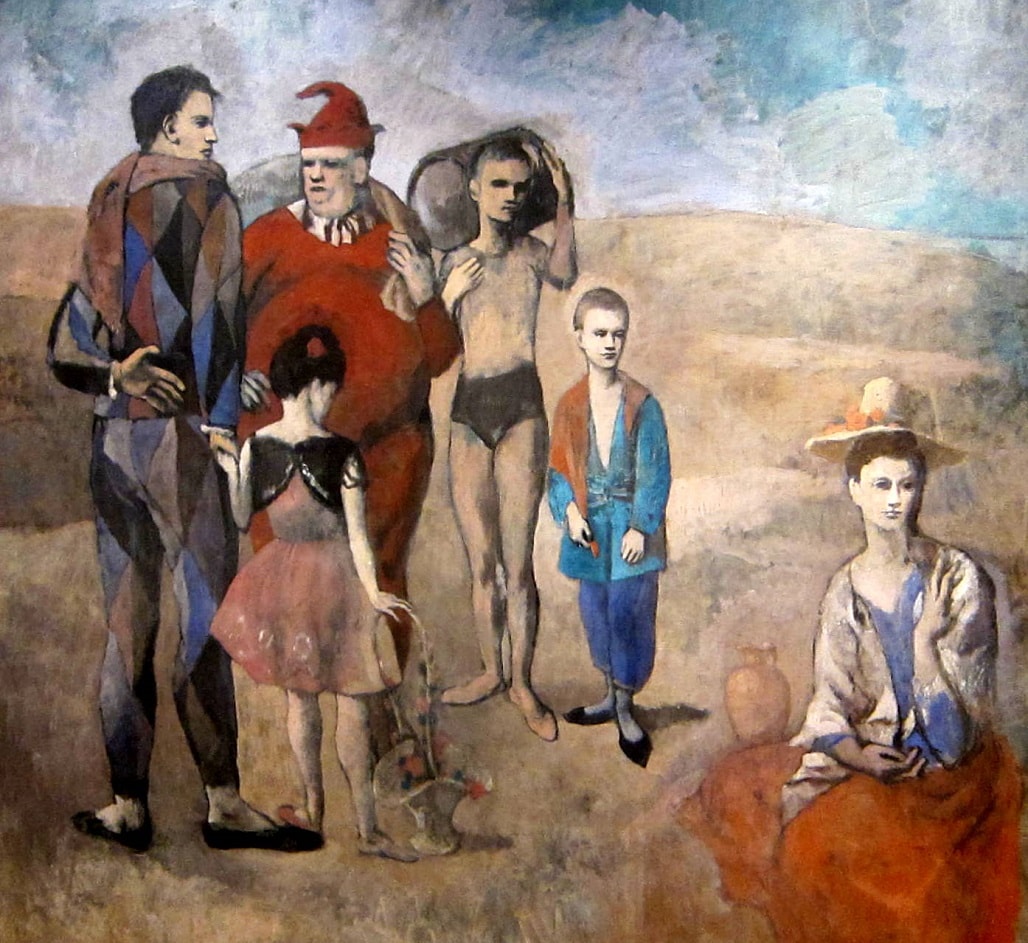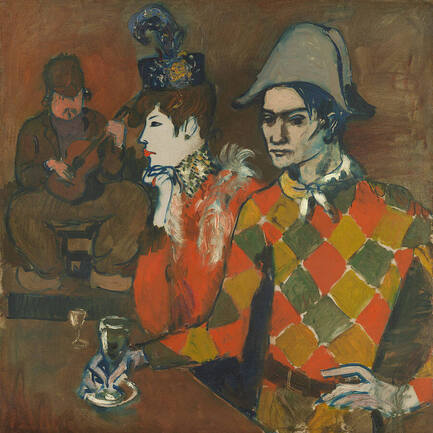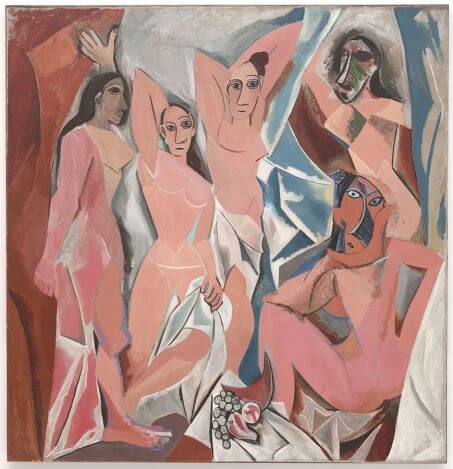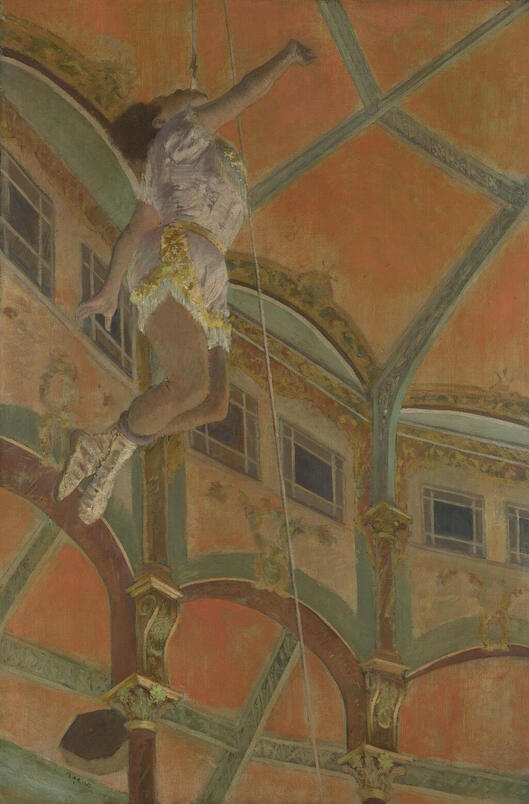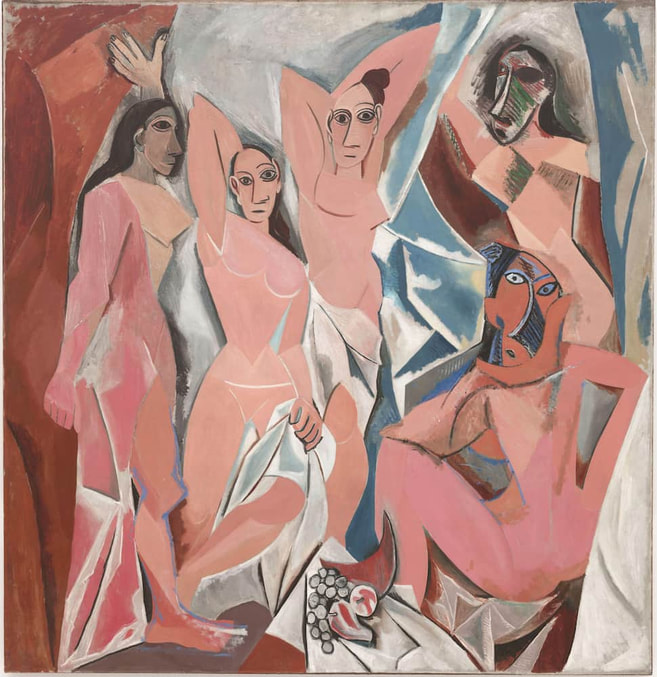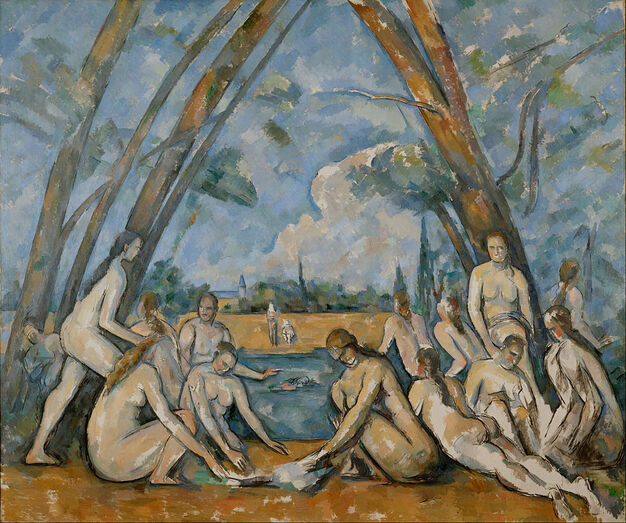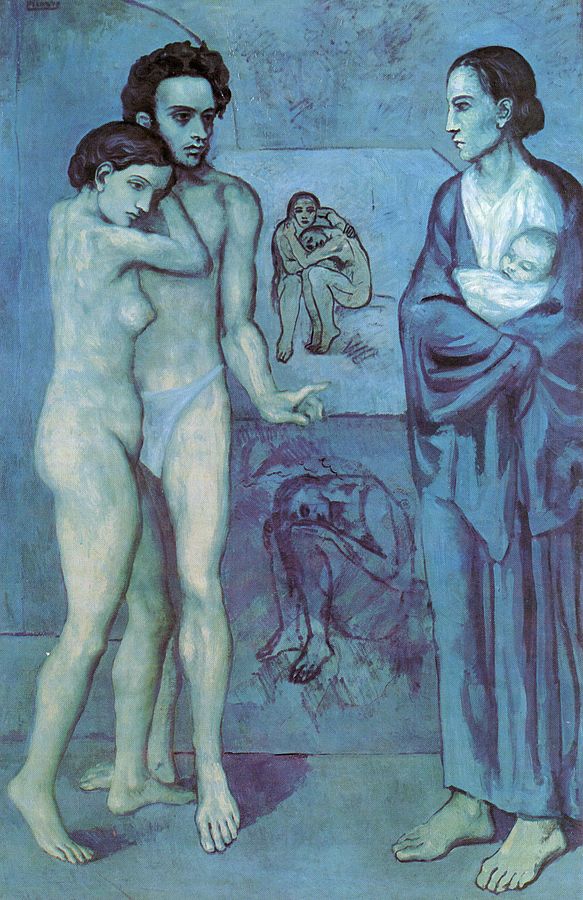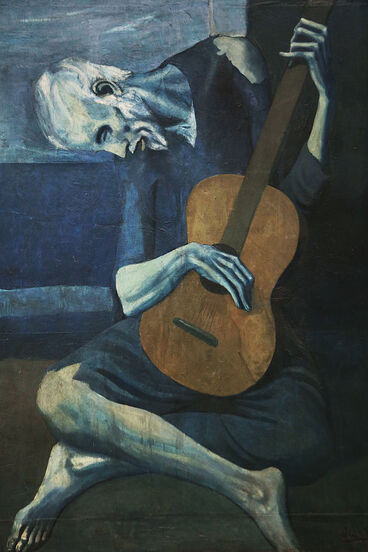|
Where? Gallery 217C of the East Building of the National Gallery of Art
When? 1905 What do you see? A group of six saltimbanques (who are traveling circus artists) against a pale background with a cloudy blue sky. The people look somber and have little expression on their faces. Picasso intended to picture the isolation and melancholy of these people. The tall harlequin on the left probably represents Picasso. He wears a suit with diamond shapes on it. He holds one hand on his back, and with the other hand he holds a young girl with a basket of flowers. The obese man to the right of Picasso is a jester with the name Tio Pepe. He wears a bright red suit and a pointed jester hat and holds a bag over his shoulder. The young man to his left only wears his underwear and holds a drum on his shoulder. The boy to his left, wearing a colorful blue jacket, is a juggler. The woman on the right, with the bright orange-red skirt, probably represents the girlfriend of Picasso, Fernande Olivier. She wears a Mallorcan costume, and she has the same flowers on her head as the small girl has in her basket. To the left of the woman is a Spanish pitcher. Backstory: Saltimbanques were traveling circus artists who could do a variety of tricks. The word saltimbanques literally means “somersault over a bench.” Picasso created this painting during five different stages over a period of nine months. He sought for perfection and was not happy with the work at the end of the first four stages. The people in this painting seem to resemble Picasso and some his friends in Paris. The men from left to right resemble Picasso, Apollinaire, Andre Salmon, and Max Weber, and the woman on the right Fernande Olivier. Picasso did not name the painting himself as he usually did not give titles to his work. In 1931, Chester Dale bought this painting and it went to the National Gallery of Art after his death in 1962. What is the Rose Period? The Rose Period refers to the period between 1904 and 1906 in the career of Picasso. It follows the Blue Period, which was between 1901 and 1904. In the Blue Period, Picasso suffered from depression after the suicide of a good friend. He primarily used somber blue and blue-green colors and focused on painting themes like hopelessness, loneliness, and poverty. In 1904, Picasso got into a good relationship with Fernande Olivier and his style changed to more happy themes and colors. In the Rose Period, he primarily used colors like red, pink, and orange, and focused on themes like acrobats, clowns, and harlequins. His paintings during this period were mainly based on his intuition rather than the direct observation of the people he depicted. The harlequin dressed in clothes with a checkered pattern was a frequently returning figure in his works, just like you can see in this painting. Another example is At the Lapin Agile in the Metropolitan Museum of Art.
Who is Picasso? His full name is Pablo Diego José Francisco de Paula Juan Nepomuceno María de los Remedios Cipriano de la Santísima Trinidad Ruiz y Picasso. He was born in 1881 in Malaga, Spain, and died in 1972 in Mougins, France.
When Picasso was 19 years old, he traveled to Paris, the art capital of Europe during that time. Over the next few years, he lived partly in Paris and partly in Barcelona. In Paris, he frequently visited the circus (sometimes multiple times per week) and the theater with friends and found his inspiration to paint circus artists. In 1905, he met Henri Matisse in Paris and they became friends for life. Picasso created many masterpieces and one of the most famous works he created, right after the Rose Period, is Les Demoiselles d’Avignon in the Museum of Modern Art in New York.
1 Comment
Where? Floor 5, Gallery 2 of the Museum of Modern Art
When? 1907 What do you see? Five nude women in a brothel. The women are not interacting with each other. The woman on the left holds back a curtain to show the other women. The woman to her right and the woman in the middle are looking boldly at the viewer while exposing their bodies. It is unclear whether they are standing or laying down. Look, for example, at the second woman from the left. Her legs are partly crossed, she has a sheet between her legs and her arm behind her head. The woman in the middle and the two women to her left have relatively normal faces. The two women on the right wear African masks. During the time that Picasso created this painting, he was interested in African artifacts, such as African tribal masks. The woman on the bottom right has her head turned around 180 degrees to look at the viewer, while the standing woman on the right appears from behind a curtain. Picasso uses a lot of angular shapes, like triangles and diamonds, in this painting, to simplify the painting and make it quite abstract. In the foreground is a table in an impossible position to hold the bowl of fruit. In the bowl, we can recognize an apple, a pear, grapes, and a pink slice of melon. Backstory: The French title of this painting is translated as ‘The Young Women of Avignon.’ Avignon refers to a notorious street in the red light district of Barcelona, Spain. Picasso was familiar with this area as he frequented it while skipping school as a teenager and he had also lived nearby it. Picasso, however, disliked the title of this painting which was given by his friend André Salmon for an exposition in 1916 of which the painting was a part of. Picasso preferred the title ‘Mon Bordel’ which means ‘My Brothel’ or ‘Le Bordel d’Avignon’ which means ‘The Brothel of Avignon.’ Fellow artists and friends were initially shocked by this painting as the women in this painting were so ugly. Nowadays, this painting is considered to be one of the most revolutionary paintings of the 20th century, and it is one of the works that marks the beginning of Modern Art. One of the closest, earlier works related to this painting is The Large Bathers by Paul Cézanne in the Philadelphia Museum of Art, created between 1898 and 1905. This is a painting that Picasso had seen shortly before finishing Les Demoiselles d’Avignon. In 1939, the Museum of Modern Art completed a $24,000 transaction to acquire this painting.
What is Cubism? The idea behind cubism is that all forms in nature can be reduced to three solids: cube, sphere, and cone. This reduction was an idea of Paul Cézanne. Basically, the objects in a painting are analyzed, divided into pieces, and then painted in a more abstract form. Thus, realistic details like perspective and color are omitted and replaced by the three solids proposed by Cézanne.
There are different stages of cubism.
Who is Picasso? Pablo Picasso (1881-1973) was born in Malaga, Spain. In his teenage years, he moved to Barcelona, but most of his adult life he lived in France. He was an artistic talent and has created many paintings, sculptures, and poems. Picasso was an innovative artist who developed a large number of art styles. Every few years he drastically changed his art style. For example, between 1901 and 1904, he was in his Blue Period. Two great examples from that period are La Vie which is at the Cleveland Museum of Art and Old Guitarist which is at the Art Institute of Chicago. Between 1904 and 1906 was his Rose Period. In the decade after his Rose Period, he developed various forms of cubism. Together with Georges Braque, Picasso pioneered the Cubist art movement, inspired by artists such as Cézanne, Gauguin, and Toulouse-Lautrec.
Fun fact: Based on sketches by Picasso, we know that he initially planned to include two additional figures in this painting (see one of those sketches here).
|
Categories
All
|
- Home
- Blog
-
Museums
- Alte Pinakothek
- Art Institute of Chicago
- Baltimore Museum of Art
- Barber Institute of Fine Arts
- Bargello
- Barnes Foundation
- British Museum
- Church of Sant’Anastasia
- Cleveland Museum of Art
- Courtauld Institute of Art
- Detroit Institute of Arts
- Frans Hals Museum
- Galleria Borghese
- Gallerie dell'Accademia
- Getty Museum
- Guggenheim
- Hermitage Museum
- Kunsthistorisches Museum
- Kunstmuseum Basel
- Legion of Honor Museum
- Louvre
- Mauritshuis
- Metropolitan Museum of Art
- Musee d’Orsay
- Museum of Fine Arts in Boston
- Museum of Modern Art
- National Gallery in London
- National Gallery of Art
- National Museum in Poznań
- Norton Simon Museum
- Ny Carlsberg Glyptotek
- Palace of Versailles
- Palazzo Pitti
- Palazzo Vecchio
- Petit Palais
- Philadelphia Museum of Art
- Prado
- Pushkin Museum
- Ravenna Art Museum
- Rijksmuseum
- San Diego Museum of Art
- Santa Maria delle Grazie
- St. Peter's Basilica
- Städel Museum
- Statens Museum for Kunst
- Tate Britain
- Tate Modern
- Timken Museum of Art
- Uffizi
- Vatican Museums
- Wallace Collection
-
Artists
- Altdorfer
- Anguissola
- Berlin Painter
- Bosch
- Botticelli
- Boucher
- Bronzino
- Bruegel the Elder
- Brunelleschi
- Cabanel
- Caillebotte
- Canova
- Caravaggio
- Carpeaux
- Cezanne
- Cimabue
- David
- Degas
- Delacroix
- De Maria
- Donatello
- El Greco
- Fontana
- Fra Angelico
- Fragonard
- Gauguin
- Gentileschi
- Gericault
- Gonzalez-Torres
- Goya
- Hals
- Hogarth
- Hokusai
- Ingres
- Leonardo da Vinci
- Lippi, Filippo
- Longhi, Barbara
- Lorrain
- Makovsky
- Manet
- Massys
- Matisse
- Merian
- Michelangelo
- Mochi
- Modigliani
- Monet
- Panini
- Parmigianino
- Perugino
- Picasso
- Pisanello
- Raphael
- Rembrandt
- Renoir
- Reynolds
- Rivera
- Rodin
- Rubens
- Scultori
- Seurat
- Steen
- Tintoretto
- Titian
- Toulouse-Lautrec
- Turner
- Uccello
- Van der Weyden
- Van Dyck
- Van Eyck
- Van Gogh
- Van Hemessen
- Vasari
- Velazquez
- Vermeer
- Veronese
- Vigée Le Brun
-
Locations
- Books
- About Us

